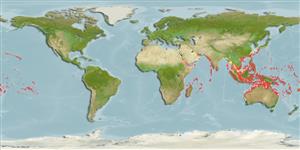Actinoptérygiens (poissons à nageoires rayonnées) >
Perciformes (Perch-likes) >
Carangidae (Jacks and pompanos) > Caranginae
Etymology: Carangoides: French, carangue, the name of a Caribbean fish; 1836 (Ref. 45335).
Environnement / Climat / Gamme
Écologie
; marin; saumâtre récifal; profondeur 1 - 60 m (Ref. 3197). Tropical, preferred ?; 37°N - 35°S, 25°E - 127°W
Indo-Pacific: Red Sea and East Africa (to Port Elizabeth, South Africa, Ref. 3197) to the Hawaiian Islands.
Taille / Poids / Âge
Maturity: Lm ? range ? - ? cm
Max length : 70.0 cm TL mâle / non sexé; (Ref. 3287); common length : 30.0 cm TL mâle / non sexé; (Ref. 9137); poids max. publié: 8.0 kg (Ref. 3287)
Épines dorsales (Total): 9; Rayons mous dorsaux (Total): 26-34; Épines anales 3; Rayons mous anaux: 21 - 26.
Adults are found in coastal waters adjacent to sandy beaches; also found to depths of 60 m, often near reefs (Ref. 30573). Pelagic (Ref. 58302). Singly or in small groups (Ref. 48635). They feed mainly on mollusks, benthic crustaceans, and occasionally on small fish (Ref. 90102) that are abundant in the lagoons. Excellent food fish (Ref. 12484), the flesh is rarely poisonous.
Life cycle and mating behavior
Maturité | Reproduction | Frai | Œufs | Fécondité | Larves
Paxton, J.R., D.F. Hoese, G.R. Allen and J.E. Hanley, 1989. Pisces. Petromyzontidae to Carangidae. Zoological Catalogue of Australia, Vol. 7. Australian Government Publishing Service, Canberra, 665 p. (Ref. 7300)
Statut dans la liste rouge de l'IUCN (Ref. 115185)
CITES (Ref. 94142)
Not Evaluated
Menace pour l'homme
Reports of ciguatera poisoning (Ref. 31637)
Utilisations par l'homme
Pêcheries: commercial; pêche sportive: oui
Plus d'informations
Noms communsSynonymesMétabolismePrédateursÉcotoxicologieReproductionMaturitéFraiFéconditéŒufsDéveloppement de l'œuf
RéférencesAquacultureProfil d'aquacultureSouchesGénétiqueFréquences alléliquesHéritabilitéPathologiesTraitementMass conversion
Outils
Articles particuliers
Télécharger en XML
Sources Internet
